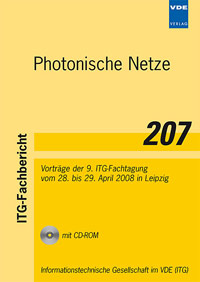107 Gbit/s RZ-DPSK Transmission using an ETDM Integrated Receiver
Konferenz: Photonische Netze - 9. ITG-Fachtagung
28.04.2008 - 29.04.2008 in Leipzig, Germany
Tagungsband: Photonische Netze
Seiten: 5Sprache: EnglischTyp: PDF
Persönliche VDE-Mitglieder erhalten auf diesen Artikel 10% Rabatt
Autoren:
Schubert, C.; Ludwig, R.; Huettl, B.; Schmidt-Langhorst, C. (Fraunhofer Institute for Telecommunication, Heinrich-Hertz-Institut, Einsteinufer 37, 10587 Berlin)
Hu, H. (School of Electronic and Information Engineering, Tianjin University, Tianjin 300072, China)
Inhalt:
High bit rate optical transmission with data rates of 100 Gbit/s and more is currently an active field of research worldwide. Serial 100 Gbit/s transmission, in contrast to parallel transmission on different wavelength channels (e.g. 10 x 10 Gbit/s or 4 x 25 Gbit/s), is seen as a cost-efficient implementation for future 100 Gb-Ethernet (100GbE) networks, in particular in the wide-area part of the network. The feasibility in terms of the technical realization of such systems based on time-division multiplexing (TDM) has already been shown using a number of different modulation formats, such as OOK („On-Off-Keying“) or DQPSK („Differential Quarternary Phase Shift Keying“). While DQPSK requires a more complex transmitter and receiver architecture it offers a higher spectral efficiency. The use of DPSK („Differential Phase Shift Key-ing“), which enables a significantly higher sensitivity in balanced detection receivers, compared to OOK, has not been experimentally investigated so far. In this paper we report on experiments in a 107 Gbit/s RZ-DPSK system. The receiver was based on pure elec-trical time-division multiplexing. It comprised a high-bandwidth balanced photodetector (u2t) and a CDR-chip („Clock & Data Recovery“, Micram) for simultaneous demultiplexing and recovery of the clock signal. The transmitter used optical time division multiplexing (OTDM) techniques. This allowed to generate a high quality 107 Gbit/s RZ-DPSK signal, which was not limited by the bandwidth of the modulator or the electrical driver amplifiers. Measurements of eye diagrams and bit-error rates for 53.5 and 107 Gbit/s are presented and com-pared. The transmission of 107 Gbit/s DPSK signals over 320 km dispersion managed fiber is demonstrated.


